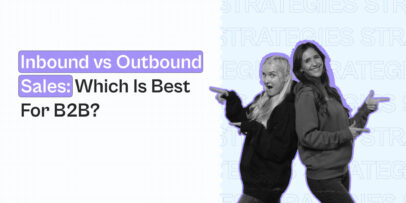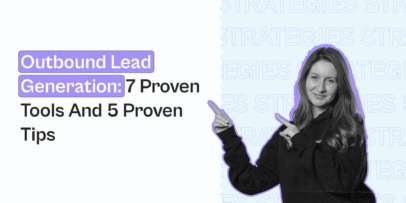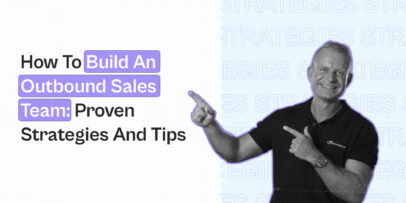What Is The Difference Between A Hot Call And A Cold Call

After more than 5 years in SDR leadership, there are a few things I’m 100% confident about.
First, cold calling is dead.
Now, before you start presenting your arguments or sharing the latest stats on SDRs cold calling, I’d like to take this moment to share my view on calling that I still trust.
In this article, I’ll be covering everything you need to know about hot and cold sales calls, as well as other proven outbound sales strategies.
Read on to see why cold calling is essentially dead, and what you should be doing for maximum sales success instead.
Here’s what we’ll cover:
- What is cold and warm calling, and what is the difference? Overview and what you should consider instead of cold calling.
- 8 Proven tactics to engage with a lead for maximum sales conversion and success.
- 3 Different multichannel outbound sales strategy cadence examples (Step-by-step, section-by-section breakdown).
Let’s get started.
Hot Call VS Cold Call: What Is The Difference And How Does Warm Calling Work?
You’re probably already familiar with what cold calling is. But before we go any further, let’s break down these definitions first so that we’re on the same page.
Here’s the exact difference between the types of calling:
- Cold calling – When a sales development representative (SDR) calls a prospect who hasn’t shown any interest in becoming a customer. The prospect might not have even heard of your brand and they could be a total stranger. Hence the reason this is a cold call. For example, calling a random number from a list of contacts.
- Warm calling – This is when a sales prospect has shown or expressed interest in your product or service. E.g. calling someone who has filled out a contact form on your website.
- Hot calling – Finally, hot calling is when a prospect is highly interested in what you offer. If they’re expecting a call from you, that means the call is hot. For example, calling a webinar attendee who scheduled a follow-up call with you after expressing interest in your offering.
And typically, implementing calls as part of your sales strategy can be important because they:
- Help you build relationships and rapport directly with the prospect.
- Feel more personal.
- Help you learn more about your target audience by asking questions and listening.
- Make you stand out from your competitors.
- Are a cost-effective way to catalyze your sales cycle with prospects that are stuck.
- Help improve your pitching and sales skills.
Need more info on this topic?
Check out our full guide and thoughts on cold email vs cold calling.
As you might have guessed, cold calling from these 3 is the least effective.
Here’s why.
Why cold calling is the least effective form of sales outreach
Let’s face it, no one likes getting calls from an unknown number.
Now imagine how your prospects feel when a stranger is calling them to sell them something they know nothing about.
But this is only the tip of the iceberg.
Putting that aside, here are a few other reasons why cold calling often fails:
- Gatekeepers and voicemails – From the go, the salesperson is fighting an uphill battle to gain the prospect’s trust and attention. If the call doesn’t get stuck in a voicemail, you still might have to deal with gatekeepers like receptionists or assistants.
- No one likes irrelevant calls – Cold calling often fails because it lacks personalization and relevance which makes other forms of outreach more effective.
- Cultural gaps – In a globalized world, sales teams often end up calling prospects from different cultural backgrounds, where communication forms vary. This can lead to misunderstandings or discomfort during cold calls.
- Time Zones – Timing is crucial in sales. If you’re calling abroad, you might catch prospects off guard or simply frustrated, based on your timing.
So, cold calling is not ideal. What should you do instead?
Here’s what you need to know.
Why warm calls are better: 5 Benefits to consider
Simply put, warm calls are more likely to convert.
Here are 5 other benefits you gain from prioritizing warm calls over cold calls.
- Established interest – By definition, warm calls are made to prospects who have already demonstrated a level of interest in what you sell. Whether they’ve filled out a form, downloaded a resource, or engaged with your content – on some level, they know about your brand.
- Higher engagement – Warm calls typically result in better engagement. Since they’ve already expressed interest, they’re more likely to listen to what you have to say and ask questions. This makes it much easier to build rapport and connection with the salesperson.
- Personalization – Another benefit of warm calls is that they offer greater personalization in your sales approach. Because you have information about the prospect’s previous interaction with your brand, you can better tailor your message to them. At the very least, you’ll know their name, pain points, and possibly even the company they work at.
- Enhanced trust and credibility – By reaching out to leads who have already engaged with your brand, you’re building upon existing trust and credibility. This makes it easier to establish a positive relationship and lay out your sales pitch. Chances are, they read your landing page, social proof testimonials, or case studies. So, they’re also more inclined to see you as an expert on the call
- Improved conversion rate – Finally, putting all the benefits above together, you’re more likely to convert the prospect into a paying customer.
That sounds great and all, but where do you get prospects for warm calls?
Let’s take a look at some proven tactics to engage with leads before calling them.
8 Proven Tactics To Engage With Leads Before A Warm Call
The whole point of warm calls is that you have relevance and reason. It’s your next step in the outbound sequence to convert the prospect into a paying customer.
If a prospect has given clear consent for you to call them, or simply gave you their number, you’re already guaranteed to perform better in sales.
From our LinkedIn poll, we’ve found that when we talk about warm calling, people most frequently think of:
- Inbound leads (41%).
- Previous interactions follow-ups (38%).
- Networking event follow-ups (14%).
- Referrals (8%).
While these are all powerful tactics to warm up a lead, it’s only the tip of the iceberg.
Here are 8 proven tactics to make sure you’re engaging with leads and warming up your prospects the right way, before calling them:
- Inbound leads – This involves promptly responding to inbound leads who filled out your online form or submitted information through your website, social media, or other marketing channels. They’ve expressed interest in your offerings, making them ideal candidates for warm calls.
- Opt-in Leads – This tactic involves calling prospects who have shared their contact information through your website form, webinar registration, or other similar contexts.
- Networking event follow-ups – This is ideal if you want to reconnect with prospects you’ve met at networking events, trade shows, or conferences. After meeting someone in person, you can follow up with prospects to continue conversations and explore potential business opportunities. Be sure to reference your initial interaction to refresh their memory and demonstrate your genuine interest.
- Follow-ups from previous interaction – If you’ve had previous communication with a prospect (e.g. through email, LinkedIn, or even in person), you can always use this as an opportunity to continue the conversation with a warm call. Similarly, be sure to refer to your previous interaction over the call to establish continuity and reinforce your interest.
- Re-engagement with dormant customers – Use your knowledge of past engagements to reach out to customers who have previously interacted with your company but have since become inactive. Rekindle the relationship and explore new opportunities for collaboration or repurchase, based on their status.
- Existing customer engagement – Use warm calls to engage existing customers for potential upselling, cross-selling, or renewal purposes. Leverage your existing relationship and knowledge to understand the needs that may benefit them and drive revenue growth.
- Referrals – Follow up with prospects who have been referred to you by existing clients, colleagues, or other contacts. Referrals often result in high-quality leads because of social proof. If your current client is referring to someone relevant who has a disposition to trust your brand, you can simply call them directly to cut through the noise.
- PLG (Product-led growth) trigger-based calls – Finally, you can also implement trigger-based calls as part of your product-led growth strategy. Identify specific actions within your product that indicate a prospect’s readiness for further engagement. Then, use these triggers to start warm calls and guide prospects through the customer journey. For example, if a user reaches a certain key milestone within your SaaS (e.g. managing over 10 projects or seats), your sales team can initiate warm calls to offer personalized guidance.
If you’re a SaaS or product business and there are no cold calls as part of your outbound strategy, focus on PLG calls instead. These calls are made after a signal from the product itself. This is only inbound, so, it makes sense for a call and certain triggers to be made within the product.
See our LinkedIn prospecting tips for more info on warm calling ideal leads.
Multichannel Outbound Sales Strategies (3 Sales Cadence Examples)
Another thing to consider when doing sales outreach has to do with your sales touchpoints.
For example, old calling random, possible leads is not the way to. Because, as mentioned above, they don’t know you and might not be relevant at all.
Instead, you can also include calling prospects as part of your multichannel outbound sales strategy.
Below, we’ll be covering 3 different sales cadence strategies and smart campaign examples, step-by-step, day-by-day.
Pro tip: You can automate a lot of the steps we’ll cover below (e.g. sending emails, connecting on LinkedIn, engaging with your audience’s content, and more) with Expandi. Based on smart actions and conditions, you can automate your entire sales outreach. So, be sure to claim your 7-day, free trial now and follow along!
14-Day sales cadence with calls

This strategy is designed to optimize outreach and follow-up efforts with the goal of engaging potential clients, nurturing leads, and closing deals.
Here’s a breakdown of this 14-day sales cadence by G2.
- Day 1: Starting the conversation – Start by crafting a concise engaging email that introduces you and your offer. Simultaneously, reach out on social media (ideally where your audience is most active. LinkedIn is ideal for this for B2B) to establish a preliminary connection and stand out in their inbox.
- Day 2: Make it personal – On the second day, follow up on your email with a personal phone call. If you reach a voicemail, leave a friendly and brief message referring to your email and your pitch. Since you’ve already reached out to the prospect before, this call won’t be completely out of the blue for them.
- Day 5: Reinforce your message – If there is no reply, send a follow-up email to your initial message, adding more details about your offer or sharing valuable insights or tips. If necessary, leave another voicemail.
- Day 6: Engage on social media – Interact with the prospect on social media (e.g. like their latest post or comment something insightful. This can be fully automated with Expandi) to get on their radar, and then, make another call attempt to touch base.
- Day 7: Integrate communication channels – Send a third email and make your fourth call. Continue the conversation with the third email that provides additional value, perhaps a relevant article or case study with social proof. Call again and leave a voicemail if they don’t answer, referencing the content you’ve sent.
- Day 9: Prioritize direct contact – Place a fifth call, signaling your commitment to connecting. Your voicemail at this point can offer a specific suggestion for a short meeting or a callback time, referring to the pain points you can help them with.
- Day 10: Use all available channels – Send your fourth email, make a sixth call, and engage on LinkedIn. Each touchpoint should offer value and signal your willingness to help.
- Day 12: Add substantial value – Before you wrap up the cadence, dispatch your fifth email and seventh call. At this stage, offer substantial value in your communication. Your email could include a testimonial, user cases, or an article showcasing your process step-by-step.
- Day 14: Conclude your initial efforts – Finally, if there is still no reply, send a final, compelling email reiterating the key benefits of your service and a final call to action.
Remember, the goal of this cadence is to provide a structure that keeps you top-of-mind with potential clients, without overwhelming them.
Tailor each communication point to be respectful and personalized. As long as you’re targeting relevant prospects with this approach, you’re bound to maximize your chances of a successful outcome.
To make things easier, you can automate a lot of the above outreach steps with Expandi.
If you have a spreadsheet of leads, you can simply export it into Expandi and set up a campaign that looks something like this.
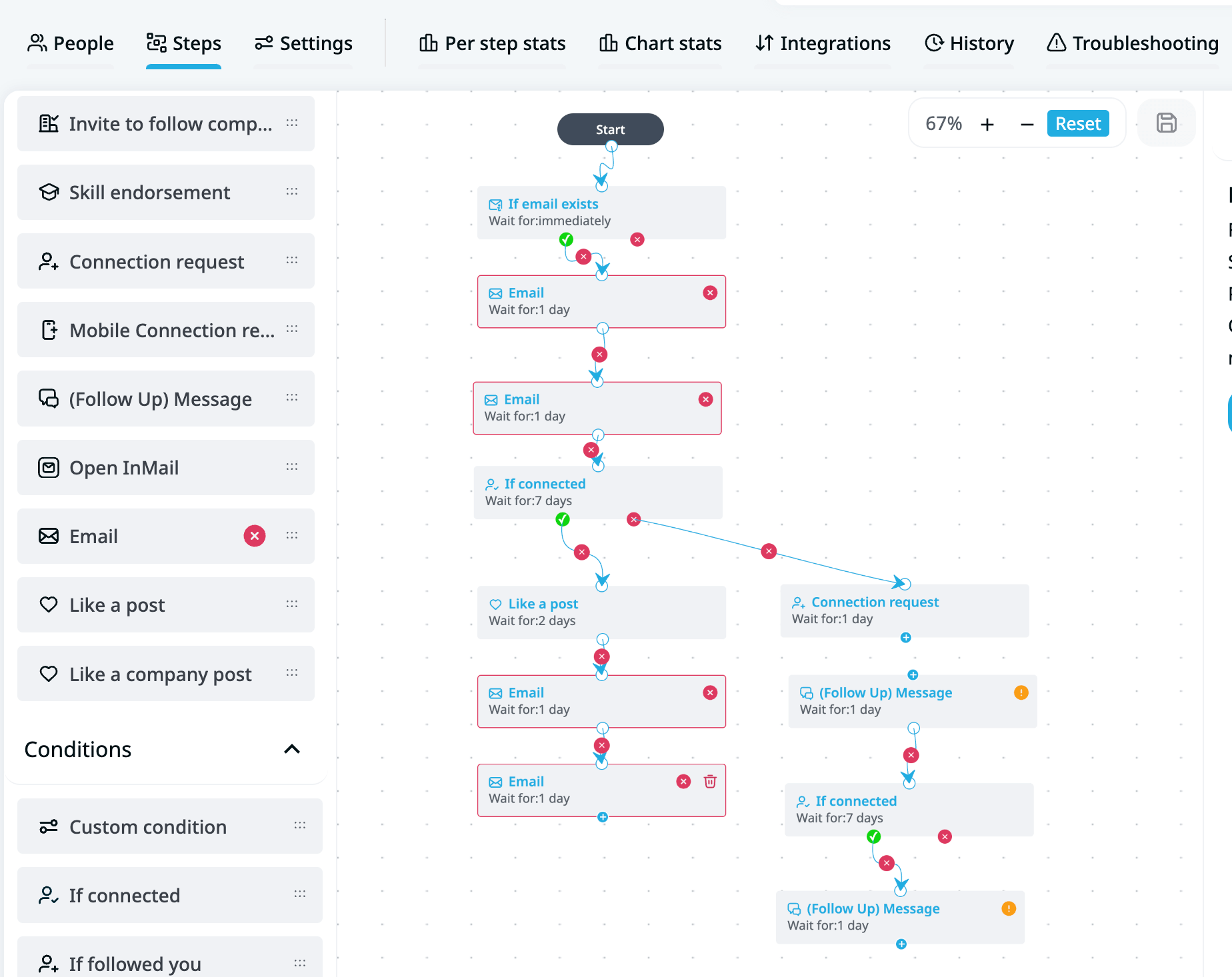
Setting up automated outreach campaigns takes less than an hour, and you start seeing results in 24 hours.
So, you can take advantage of the free, 7-day Expandi trial, land one paying client, and have the tool pay for itself.
Now, let’s get back on topic.
21-Day sales cadene with 12 touchpoints
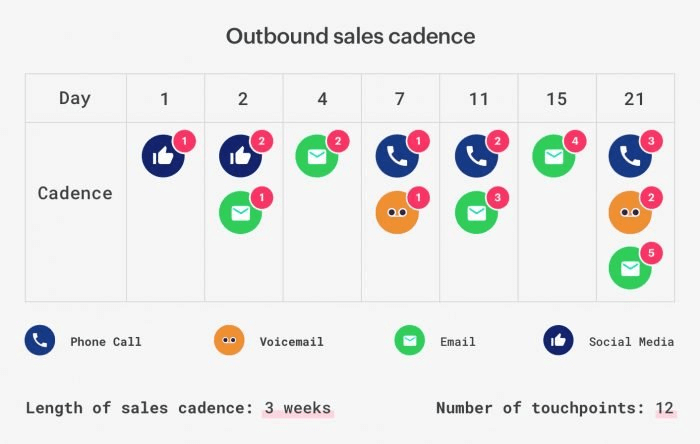
This sales cadence focuses on warming up the prospects first before introducing the first call.
Here’s how it works.
- Day 1: Establish the initial connection by introducing yourself and your company. You can like their content on LinkedIn, leave a comment, or directly send a connection request.
- Day 2: If they’ve accepted your request, send a follow-up with your pitch. If not, like their content, send your first email with your pitch.
- Day 4: Your second email should build on the previous communications and may include more detailed information about your product or service (e.g. how it works and what makes it different).
- Day 7: Here, you’ll want to make your first phone call to introduce yourself personally. This approach is important to establish a human connection and show you’re reaching out directly, and not spamming them online. If they don’t answer, leave a voicemail, referring to how you tried to get in touch via email and LinkedIn.
- Day 11: Follow up via phone call and email. By now, you should have a better understanding of their needs, which should guide your conversation or voicemail. Mention their pain points and that you’ve done your research.
- Day 15: Send your fourth email. This could be an opportunity to provide a case study, customer testimonial, results, or an invite to a webinar relevant to their interests.
- Day 21: Finally, diversify your touchpoints before ending the sales cadence. Start with your third call to reiterate your value proposition and make a personal request for a meeting or conversation. If they don’t pick up, leave a short voicemail, and a final email with a clear, compelling call to action, mentioning you won’t contact them again.
To keep things simple and save time, you can use Expandi free trial to automate all parts of your online outreach (sending LinkedIn requests, follow-ups, content engagement, and more).
25-Day sales cadence strategy

Last but not least, here’s the 3rd sales cadene strategy you can focus, which is split across 4 sections, based on different levels of activity.
Section 1: The density days
- Step 1, day 1: Send out an introductory email. Since this is your first touchpoint, make it count with a strong opening and a clear value proposition.
- Step 2, day 1: On the same day, send a LinkedIn connection request to add a social layer to your approach. Personalize it and mention your email to improve your chances of acceptance.
- Step 3, day 2: Make a cold calling following the above to show your initiative and increase visibility.
- Step 4, day 2: To end the first section, send a second email, as a follow-up to your call to reinforce your message.
Section 2: Repeat yourself
- Step 5, day 5: Follow up with another call to remind the prospect of your services and your previous touchpoints.
- Step 6, day 5: Send another email on the same day as your call. It should continue the conversation. If they haven’t picked up your call from the previous step, mention you left a voicemail.
- Step 7, day 8: 3 days later, send another email to maintain the connection and ensure your prospect has all the necessary information to consider your proposal.
Section 3: Gear shift
- Step 8, day 11: Start the 3rd section with another phone call. From here on out, your sales approach should be based on the interactions you’ve had so far with the prospect.
- Step 9, day 11: On the same day, send a video email. This can be a Loom video showcasing your product or solution or answering questions in a more personal and engaging way.
- Step 10, day 14: 3 days later, follow up with another phone call to discuss any thoughts they might have after viewing your video.
- Step 11, day 14: Also on day 14, send an additional email. This can be used to summarize your previous communications and highlight key points.
Section 4: Let it ride
- Step 12, day 17: Start the final section by sending an email that gives the prospect some space, possibly with a softer call to action or an invitation to ask questions.
- Step 13, day 20: Follow up with another email, providing new information or an invocation to a relevant event or webinar with value.
- Step 14, day 24: Send your latest planned email, with a strong, final offer or call to action.
- Step 15, day 25: Finally, end your sales cadence with a disposition step. Assess the situation based on the interactions you’ve had and make a decision accordingly. You can close the file, continue nurturing the lead, or set up a follow-up task for the future, based on your unique interactions.
Throughout this cadence, your communication should adapt to any feedback or replies you receive.
This approach is methodical, with a mix of touchpoints designed to engage the prospect in various ways over time. Allowing the prospect to become familiar with your brand and ask questions, increasing the chances of a successful sale.
Final Words
To recap, never neglect the power of the call.
It’s natural to feel afraid or anxious to call your prospects on the phone directly.
But guess what?
As long as you have a real, relevant reason to call them, they’ll be open to hearing you out.
Additionally, many sales teams are neglecting cold calling over LinkedIn and email outreach.
LinkedIn is very effective, don’t get me wrong, but many sales teams are completely ignoring picking up the phone.
Which is why you can use this to your advantage to cut through the noise and stand out.
Sales is indeed a numbers game.
But in 2024, relevancy and signal-based calls are key.
If you master those, your sales numbers will skyrocket.
Though, of course, calling works best in conjunction with other sales tactics, such as LinkedIn and email.
And to get the most out of everything we’ve covered so far, you should also take advantage of automation.
With Expandi, you can fully automate your sales outreach, based on actions and conditions.
So, claim your free, 7-day trial here and start booking meetings on autopilot today!
You’ve made it all the way down here, take the final step
